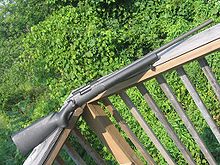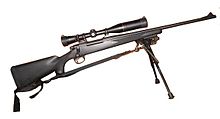Remington Model 700
This article has multiple issues. Please help improve it or discuss these issues on the talk page. (Learn how and when to remove these messages)
|
The Remington Model 700 is one of a series of bolt-action (later semi-automatic 74* series) centerfire rifles manufactured by Remington Arms since 1962. It is a progressive variant of the Remington Model 721 and Model 722 series of rifles which were introduced in 1948. The M24 and M40 military sniper rifles are used by the United States Army and United States Marine Corps respectively and are both based on the Model 700 design.
The Remington 700 series rifles often feature a 3, 4, or 5-round internal magazine depending on the caliber. Some models include a hinged floor-plate for quick unloading, while others are “blind”, lacking a floor-plate. The rifle may also be configured with a detachable box magazine. The Model 700 is available in many different stock, barrel, and caliber combinations, with many third-party and after-market variants built on the same action footprint. From 1978 to 1982, Remington offered the Sportsman 78, which had the same Model 700 action but with lower-cost features, such as a plain stock without non-slip checkering.
Development
[edit]After World War II, Remington Arms engineer Merle "Mike" Walker designed lower-cost alternatives to the Model 30, resulting in the Model 721. These used a cylindrical receiver produced from cylindrical bar stock that could be turned on a lathe, rather than machined in a series of milling operations, which significantly reduced the cost of production. Furthermore, small metal parts, including the bottom metal, were stamped, and the stocks were finished to a lower standard than older models. The Model 721 saw further development under the direction of Walker, which resulted in the Model 722, 725 and ultimately the Model 700 in 1962.[1]
Walker sought to increase the accuracy of the rifles by utilizing tight tolerances in the chamber and bore, a short leade, and a much faster lock time. Like the earlier Model 721, the Model 700 was designed for mass production.[2] Remington initially produced two variants of the Model 700: the ADL and BDL, in both long and short action rifles that allowed for the chambering of different cartridges.
In 1969, Remington introduced several upgrades to the rifle, including a longer rear bolt shroud, a jeweled bolt and improved stock finishing. Four years later, the production of left-handed versions of the rifle began to compete with the Savage Model 110, which was at that time the only major rifle manufactured with a left-handed variant. Since then, various versions of the rifle, including the titanium receiver 700 ti, the 700 SPS (which replaced the ADL in 2005), and the CDL have been introduced. In addition to it being catered as a hunting rifle, the Model 700 also provided the basis for military and police sniper rifles, starting with the M40 rifle in 1966 which was initially ordered by the U.S. Marine Corps. The U.S. Army adopted the M24 Sniper Weapon System in 1986.[3]
Design
[edit]The Remington 700 is a manually operated bolt action rifle with two forward dual-opposed lugs. The bolt face is recessed, fully enclosing the base of the cartridge. The extractor is a C-clip sitting within the bolt face. The ejector is a plunger on the bolt face actuated by a coil spring. The bolt is of 3-piece construction (head, body and bolt handle), brazed together. The receiver is milled from round cross-section steel.[2]
The Remington 700 comes in a large number of variants.
- The symmetrical two-lug bolt body has a .695 in (17.65 mm) diameter.[4]
- The long action — designed for full-length cartridges up to 3.340 inches (84.84 mm) in overall length, such as the .30-06 Springfield, and magnum cartridges, such as the 7mm Remington Magnum and .300 Winchester Magnum — has a lock time of 3.0 to 3.2 milliseconds.
- The short action designed for cartridges having an overall length of 2.750 inches (69.85 mm) or less, such as the .308 Winchester/7.62×51mm NATO, has a lock time of 2.6 milliseconds.[5][6]
The rifles are designed to accept different magazine configurations — a blind magazine without a floor-plate, a conventional magazine with a detachable floor-plate, and a detachable box magazine. There are standard consumer versions as well as versions designed for military and police use. Some variants also have bipods, slings and other accessories.[7]
Standard versions
[edit]
Remington produces the Mountain LSS model with a stainless steel barrel and laminated stock. Heavy barrel versions with laminated stocks like the Model 700 SPS Varmint are available for varmint hunting. The Model 700 ADL was replaced as the most economical Model 700 by the Model 700 SPS (Special Purpose Synthetic) in newer production.[8]
Remington also produced a 700 ML (muzzle loader) rifle from 1996-2004.[9]
The EtronX electronic primer ignition system was implemented in the Model 700 EtronX introduced in 2000, though this model was a commercial failure and ceased production in 2003 along with the EtronX primers.[10]
Police version
[edit]
Remington markets the 700 to military forces and civilian law-enforcement agencies under the "Remington Law Enforcement" and "Remington Military" banners, with the military/law enforcement 700s referred to as the Model 700P ("Police").[11][12]
The 700P series appears to have been influenced by the designs, features and success of the M24 Sniper Weapon System and the M40 series; for instance, the Model 700P series features a heavier and thicker barrel for increased accuracy and reduced recoil.[citation needed]
The rifle is chambered for the .308 Winchester cartridge as well as the .223 Remington, .243 Winchester, 7mm Remington Magnum, .300 Winchester Magnum, .300 Remington Ultra Magnum and .338 Lapua Magnum. The 700P has a 26" barrel and aluminum block bedding in its stock made by HS Precision.
Remington also sells the standard U.S. Army-issue Leupold Mark IV M3 10x40mm telescopic sight used by the Army's M24 as an optional feature.
Remington offers similarly styled, less expensive versions under the Special Purpose Synthetic (SPS) name.[13]
Military version
[edit]This section needs additional citations for verification. (December 2024) |

Both the U.S. Army's M24 Sniper Weapon System and U.S. Marine Corps' M40 sniper rifles are built from the Remington Model 700 rifle with different degrees of modification, the main difference being the custom fitted heavy contour barrel and action length. The M24 utilizes the long action and the M40 employs the short action bolt-face, as the M24 was originally intended to chamber the longer .300 Winchester Magnum round. The M40, however, was not intended to chamber the more powerful .300 Winchester Magnum round, yet the Marine Corps' intention was to migrate to the .300 Winchester Magnum cartridge. The Marine Corps' delay has led to a change in the migratory direction. The goal was for the M40 to become a rifle chambered in .338 Lapua Magnum.[14]

The United States Army's Joint Munitions and Lethality Contracting Center awarded Remington a Firm Fixed Price (FFP) Indefinite Delivery/ Indefinite Quantity (IDIQ) contract (W15QKN-10-R-0403) for the upgrade of up to 3,600 M24 Sniper Weapon Systems (SWS) fielded to the Army, pending type classification as the “M24E1”.[15] The major configuration change for this system was the caliber conversion from 7.62mm NATO (.308 Winchester) to .300 Winchester Magnum to provide soldiers with additional precision engagement capability and range.
The contract was for a five-year period with a guaranteed minimum value of $192K and a potential value of up to $28.2 million.[16] This award followed a full and open competitive evaluation lasting nine months, which began with the release of the Army's Request for Proposal (RFP) on January 13, 2010. The program was executed under the authority of Project Manager Soldier Weapons, Picatinny Arsenal, New Jersey, and managed by its subordinate unit, Product Manager Individual Weapons.[citation needed]
In 2009, the U.S. Army changed the weapon name from M24E1 to XM2010 Enhanced Sniper Rifle.[17]
Model Seven version
[edit]The Remington Model Seven carbine is a compact version of the Remington 700 built around a short action and chambered in the .223 Rem and .308 Win class cartridges. Introduced in 1983, the stock is shorter than the standard version and the barrel is only 18.5".[18]
Users
[edit]
 Australia: New South Wales Police Force State Protection Group[19]
Australia: New South Wales Police Force State Protection Group[19] Canada: Royal Canadian Mounted Police (RCMP).[20]
Canada: Royal Canadian Mounted Police (RCMP).[20] China: Remington 700 PSS used by People's Armed Police[21]
China: Remington 700 PSS used by People's Armed Police[21] Indonesia: Komando Pasukan Katak (Kopaska) tactical diver group and Komando Pasukan Khusus (Kopassus) special forces group.[22]
Indonesia: Komando Pasukan Katak (Kopaska) tactical diver group and Komando Pasukan Khusus (Kopassus) special forces group.[22] Israel: Israel Police and Israel Defense Forces special forces, replaced by Mauser 86 SR and M24 SWS[23]
Israel: Israel Police and Israel Defense Forces special forces, replaced by Mauser 86 SR and M24 SWS[23] Malaysia: Pasukan Gerakan Khas (PGK).[24]
Malaysia: Pasukan Gerakan Khas (PGK).[24] Philippines: Philippine Marine Corps (PMC).[25]
Philippines: Philippine Marine Corps (PMC).[25] Sierra Leone: Sierra Leone Police[26][self-published source?]
Sierra Leone: Sierra Leone Police[26][self-published source?] Ukraine: Ukrainian Army[27]
Ukraine: Ukrainian Army[27] United States: United States Border Patrol,[28] United States Marine Corps, United States Navy, United States Army,[29] Cambridge Police Department (Massachusetts).[30]
United States: United States Border Patrol,[28] United States Marine Corps, United States Navy, United States Army,[29] Cambridge Police Department (Massachusetts).[30]
Controversy
[edit]This section needs to be updated. (May 2022) |
Thousands of Remington Model 700 customers have complained to Remington that a defect in the trigger mechanism could fire the gun without the trigger being squeezed.[31][32] Remington received nearly 2,000 complaints from 2013 through 2016[32] and 150 lawsuits have been filed against Remington alleging injury or death related to the trigger.[32] Lawsuits have alleged that Remington covered up a design flaw in the trigger mechanism resulting in dozens of deaths and hundreds of serious injuries.[33] A class action lawsuit alleges Remington knowingly sold a defective product.[32] The Attorneys general from nine states and the District of Columbia objected to the proposed settlement in the class action, saying that Remington has "long known" of the defect and that the proposed settlement "fails to adequately protect public safety."[34]
On October 20, 2010, CNBC televised the first in an ongoing investigative series, Remington Under Fire: a CNBC Investigation, reporting that the trigger mechanism used prior to 2007 on the Model 700 could fire without the trigger being squeezed. The report stated that Remington has received thousands of customer complaints since the firing mechanism was introduced in the 1940s and that nearly two dozen deaths and hundreds of injuries had been attributed to inadvertent discharges of 700 series rifles. Through internal Remington documents, the program showed that on multiple occasions the company considered recalling the product.
The inventor of the firing mechanism, Mike Walker, 98 years old at the time of the documentary, told CNBC he proposed what he called a safer trigger in 1948 while the product was still in the testing stage. Walker said his enhanced design was rejected because of the added cost, 5 1/2 cents per gun (adjusted for inflation: $0.7).[31] Critics of the documentary countered that every incident featured on the program involving loss of life was the result of firearms mishandling where owners pointed their rifles at other human beings.[35] Remington responded with the Remington Model 700 Network which gave direct rebuttals to the program, and their perspective on the incidents the program describes.[36] Remington dismisses the allegations, pointing out that in every case either trigger mechanisms of the rifles were adjusted or altered beyond recommended specifications,[37] rifles were poorly maintained and left to rust, or was a result of misuse of the rifle. Those involved admitted to police they might "possibly" have pulled the trigger.[36]
Though Remington has since changed to a new, cheaper, trigger mechanism design, the original Walker trigger is still produced for the U.S. military and buyers of custom rifles.[36]
On December 6, 2014, Remington announced that as part of actions put into place to settle multiple lawsuits and to avoid future legal actions, they are replacing all triggers in the Model 700s.[38] Over 7.85 million rifles are included in this agreement, making all of them eligible for replacements.
On February 19, 2017, CBS News' 60 Minutes aired a segment on the Remington 700 trigger mechanism safety. The episode highlighted incidents of accidental deaths as a result of Remington 700s firing without the trigger being pulled, problems with Remington's trigger mechanism replacement program, and a class-action lawsuit filed by Remington owners.[32]
See also
[edit]Footnotes
[edit]- ^ van Zwoll, pp. 55–58
- ^ a b de Haas, pp. 249–251
- ^ van Zwoll, pp. 58–60
- ^ "Remington 700 Action Lengths". www.nzhuntingandshooting.co.nz. Retrieved January 2, 2025.
- ^ van Zwoll, p. 58
- ^ Locktime by Randy Wakeman
- ^ "Remington 700 Bipod | ON SALE". www.mountsplus.com. Retrieved January 2, 2025.
- ^ Mark Kayser, "Long-gun sales target trends: know the market and your customers for real success!", Shooting Industry (August 2006 ed.)
- ^ "Model 700 ML | Remington". www.remarms.com. Retrieved January 4, 2025.
- ^ van Zwoll, p. 60
- ^ "Remington M700 Police". Weaponsystems.net. Retrieved January 4, 2025.
- ^ "Model 700 | Remington". www.remarms.com. Retrieved January 4, 2025.
- ^ "Model 700 | Remington". www.remarms.com. Retrieved January 4, 2025.
- ^ "M24 Sniper Rifle". Military.com. Archived from the original on November 15, 2010. Retrieved August 10, 2010.
- ^ "Remington Awarded Army Contract to Reconfigure Sniper Rifle | SGB Media Online". sgbonline.com. Retrieved January 4, 2025.
- ^ "10--M24 Sniper Weapon System Reconfiguration".[dead link]
- ^ Lance M. Bacon (April 30, 2011). "Improved carbines headed your way". Army Times.[dead link]
- ^ "My Remington Model Seven: A Faithful Family Friend". www.americanrifleman.org.
- ^ "Sydney Siege - The Firearm Blog". January 8, 2015.
- ^ "Canadian Forces Small Arms Competitions" (PDF). Archived from the original (PDF) on July 6, 2011. Retrieved February 4, 2011.
- ^ "狙击手载誉归来 ——访国际军警狙击手射击锦标赛武警代表队 总教官王宝来 - 本刊专递 - QBQ-轻兵器". Archived from the original on November 24, 2018. Retrieved November 24, 2018.
- ^ "Kopassus & Kopaska – Specijalne Postrojbe Republike Indonezije" (in Croatian). Hrvatski Vojnik Magazine. Archived from the original on August 22, 2010. Retrieved June 12, 2010.
- ^ "isayeret.com | The Israeli Special Forces Database". isayeret.com. Retrieved February 27, 2021.
- ^ Thompson, Leroy (December 2008). "Malaysian Special Forces". Special Weapons. Retrieved November 29, 2009.
- ^ "The Philippine Marine Corps Scout Sniper Program". Archived from the original on January 11, 2008. Retrieved May 22, 2009.
- ^ "World Infantry Weapons: Sierra Leone". 2013. Archived from the original on November 24, 2016.
- ^ TAB (April 17, 2022). "Savage Arms Rifles in Ukraine". The Armourers Bench. Retrieved July 9, 2022.
- ^ Krieger, Jim (March 9, 2010). "Guns of the United States Border Patrol". Human Events. Archived from the original on May 7, 2010. Retrieved September 2, 2010.
- ^ Senich, Peter R. (1988). Complete Book of U.S. Sniping. Boulder, CO: Paladin Press. p. 28. ISBN 978-1-58160-610-2.
- ^ C, Luke (February 26, 2021). "Cambridge Police Commissioner makes Plans to Reduce Gun Inventory". The Firearm Blog.
- ^ a b Cohn, Scott (October 20, 2010). "Remington Under Fire: A CNBC Investigation". CNBC. Retrieved August 8, 2011.
- ^ a b c d e Stahl, Lesley (February 19, 2017). "Popular Remington 700 rifle linked to potentially deadly defect". 60 Minutes. CBS News. Retrieved February 27, 2017.
- ^ Cohn, Scott (February 14, 2017). "Is Remington getting too good a deal in rifle settlement? Judge wants to know". CNBC. Retrieved February 27, 2017.
- ^ Cohn, Scott (January 18, 2017). "States join objections to Remington rifle settlement". CNBC. Retrieved February 27, 2017.
- ^ David E. Petzal. "CNBC's Remington 700 Trigger Coverage A Clean Mis s". Field & Stream.
- ^ a b c "remington700.tv" (PDF). www.remington700.tv. Archived from the original (PDF) on October 30, 2011. Retrieved July 31, 2011.
- ^ "Remington answers legal attacks". Shooting Industry (May 1993 ed.). Archived from the original on January 9, 2016.
- ^ "Remington agrees to replace millions of allegedly faulty triggers", 12/06/14, Scott Cohn, MSNBC
References
[edit]- De Haas, Frank (1971). Bolt Action Rifles. Northfield: DBI Books. ISBN 0-695-80220-8.
- Van Zwoll, Wayne (2012). Gun Digest Shooter's Guide to Rifles. Iola: Gun Digest Books. ISBN 978-1440230721.
External links
[edit]- CNBC program on the Remington 700
- Remington Under Fire investigative journalism since 2010 by CNBC
- Remington Model 700 product page
- Remington Model 700 product page 2023

